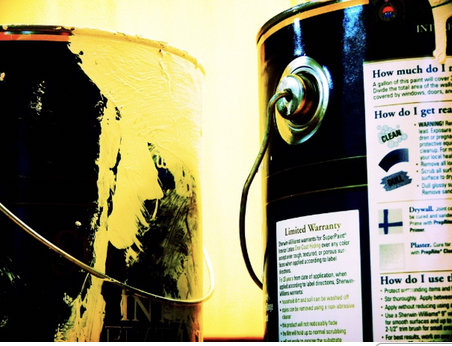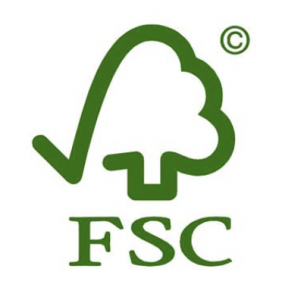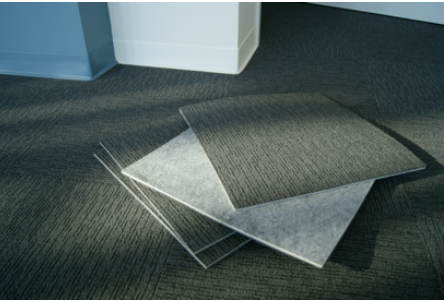Non-toxic Materials
Existing CommercialWhat are Non-toxic Materials?
Non-toxic or low-emitting materials release relatively low levels of odorous, irritating, toxic, or hazardous substances unhealthy to building occupants.[1] Volatile organic compounds (VOCs) (including formaldehyde), particulates, and fibers include substances often emitted from building materials that can adversely impact human health.
Volatile Organic Compounds (VOCs) contain carbon molecules and can vaporize from material surfaces into indoor air at average room temperatures (a process known as off-gassing).[2] A non-toxic material must meet different thresholds of VOC emissions compliance depending on the material.[3] Found in many everyday products and building materials, VOCs can escape into the air and cause illness and allergic reactions. Studies have linked elevated levels of VOCs and interior pollutants to health concerns that cause eye, nose and throat irritation, headaches, loss of coordination, nausea, and other health problems. [4] People with respiratory problems, children, seniors and people with compromised immune systems are at higher risk to reactions from exposure than general population.
According to the EPA, concentrations of many VOCs are consistently higher indoors (up to ten times) than outdoors. Paints, sealants, manufactured wood products, and adhesives as well as some furnishings and carpet systems often release VOCs. Inherently non-emitting sources of VOCs such as stone, ceramic, powder-coated metals, plated or anodized metal, glass, concrete, clay, brick, and unfinished or untreated solid wood do not require VOC emissions testing if they do not include VOC emitting surface coatings, binders, or sealants.[5]
Formaldehyde (CH2O), a known carcinogen, is a colorless gas with a strong odor that can cause eye, nose, skin, and lung irritations. It forms an essential component of several polymers used in many building materials including urea formaldehyde, phenol formaldehyde, and melamine resin. When selecting safe, non-toxic materials, avoid building materials and products containing formaldehyde resins. Pressed-wood products, such as particleboard, oriented strand board (OSB), plywood, medium density fiberboard, glues and adhesives, permanent-press fabrics, paper product coatings, and specific insulation materials often use formaldehyde resins.[6] More information about formaldehyde can be found through resources such as the US EPA website. If a formaldehyde-containing product is purchased, it should be aired out before it is used.

Figure 1 – Paint cans (Source: Maury McCown)
How to Incorporate Non-toxic Materials
Increased awareness about possible health risks and indoor air quality concerns have helped to expand the market for safe, non-toxic materials. Low-emitting material credit requirements by LEED and other green building certifications have led to a demand for products lower in VOCs and toxic chemicals.[7] Several certification programs, standards, and criteria for selecting and evaluating sustainable materials include GREENGUARD (indoor air quality certification), Green Label Plus (carpets/rugs), Green Seal, and Scientific Certification Systems.
The definition of a “low” concentration of VOC emissions varies according to the product type. For example, for interior paints and coatings, low-VOC emitting products have concentrations below 50 g/L; a zero-VOC paint has fewer than 5 grams per liter.[8] Paints and finishes come in either oil-based formulas or latex (water) based, which are generally less toxic and less VOC-emitting than oil-based paints.[9] Not all latex-based formulas are low in VOC’s, however, and a few oil-based products now qualify as low-VOC. For independent certifications and standards, see greenseal.org and greenguard.org (which measures VOC emissions).
There are many hard, low-formaldehyde flooring materials on the market. Formaldehyde occurs naturally in wood and making wood-containing flooring products are never 100% formaldehyde free. By using materials such as concrete and recycled tile, a homeowner can significantly reduce the amount of formaldehyde concentration in a home, while also preserving natural resources such as wood commonly used for flooring.

Figure 5 – FSC Certified Logo
If choosing to install new wood, consider salvaged wood or look for products that earn the Forest Stewardship Council (FSC)-certification label. The FSC specializes in providing certification for wood products produced from sustainable harvesting practices that contain low levels of formaldehyde. FSC-certified wood floors do not include added urea-formaldehyde.
Example
Rutgers University Visitor Center
The Rutgers University Visitor Center was constructed using low-emitting materials including paints, finishes and recycled content carpet.

Figure 3 – Stained concrete floor (source: Rutgers Center for Green Building)

Figure 4 – Recycled carpet (source: Rutgers Center for Green Building)
Benefits
The selection of building material and furnishings have a significant impact on indoor environmental quality. Benefits of choosing low-emitting materials include: [10]
- Improved indoor air quality.
- Improved worker safety and health.
- Reduced incidents of an eye and respiratory irritation, headaches, fatigue.
- Healthier environment for building occupants who are sensitive to specific products.
- Reduced pollution of groundwater and water supplies.
Costs
Many low-emitting materials are cost-competitive with conventional materials. Low/no-VOC paints typically cost about the same as conventional paints.[11] Many wood product manufacturers are replacing formaldehyde-based bonding resins with non-toxic substitutes. Cost impacts for such non-formaldehyde wood products can vary.[12]
Resiliency
The use of non-toxic materials in building assemblies and furnishings can help to reduce the release of toxic chemicals when debris from buildings finds its way into the environment following storm surges, flooding, and high winds caused by natural disasters and severe storm events. For example, Superstorm Sandy generated over 8 million cubic yards of debris across the nine hardest-hit counties in New Jersey in only one day.[13] Damaged and contaminated materials may include waterlogged drywall, plaster, insulation, flooring, carpets, mattresses, and upholstered furniture, that when put it into unlined landfills, can contaminate groundwater.
[1] Los Alamos National Laboratory Sustainable Design Guide, Chapter 6: Materials. https://www.energy.gov/sites/prod/files/2013/12/f5/sustainable_guide_ch6.pdf (accessed April 27, 2018).
[2] Whole Building Design Guide (WBDG). Evaluating and Selecting Green Products. https://www.wbdg.org/resources/evaluating-and-selecting-green-products (accessed April 27, 2018).
[3] LEED BD+C: New Construction | v4 – LEED v4. Low-emitting materials
https://www.usgbc.org/credits/new-construction-core-and-shell-retail-new-construction-data-centers-new-construction-hosp-0 (accessed April 25, 2018).
[4] US EPA. An Introduction to Indoor Air Quality. https://www.epa.gov/indoor-air-quality-iaq/volatile-organic-compounds-impact-indoor-air-quality (accessed April 23, 2018).
[5] LEED v4. EQ Credit Low-Emitting Materials Third Party Certifications and Labels. https://www.usgbc.org/sites/default/files/Low%20Emitting%20Third%20Party%20Certifications%20and%20Labels%20June%202017.pdf (accessed April 27, 2018).
[6] Healthy Building Network. Formaldehyde Found in Building Materials. https://healthybuilding.net/uploads/files/formaldehyde-found-in-building-materials.pdf (accessed April 27, 2018).
[7] LEED v4. EQ Credit Low-Emitting Materials Third Party Certifications and Labels. https://www.usgbc.org/sites/default/files/Low%20Emitting%20Third%20Party%20Certifications%20and%20Labels%20June%202017.pdf (accessed April 27, 2018).
[8] GreenGuard. Your Guide to Low-And Zero-VOC Paints. http://greenguard.org/files/LivingGreenPaintGuide.pdf (accessed April 27, 2018).
[9] Ibid.
[10] WBDG. Evaluating and Selecting Green Products. https://www.wbdg.org/resources/evaluating-and-selecting-green-products (accessed April 27, 2018).
[11] Cost Helper. How Much Does Painting an Interior Cost? http://home.costhelper.com/painting-interior.html (accessed April 27, 2018).
[12] Los Alamos National Laboratory Sustainable Design Guide, Chapter 6: Materials. https://www.energy.gov/sites/prod/files/2013/12/f5/sustainable_guide_ch6.pdf (accessed April 27, 2018).
[13] NJ DEP. (2015). Disaster Debris Management Planning Tool Kit for New Jersey Municipalities.
http://www.nj.gov/dep/dshw/toolkit.pdf (accessed April 27, 2018).
Related Strategies
Resources
- NJ Department of Health and Senior Services – Indoor Environments
- US EPA Indoor Air Quality – Green Indoor Environments
- Whole Building Design Guide (WBDG): Evaluating and Selecting Green Products
Green Product Certifications and Standards:
- Carpet and Rug Institute (CRI) Green Label Program
- Cradle to Cradle
- The GREENGUARD Environmental Institute is an industry-independent, not-for-profit organization that oversees the GREENGUARD Certification programs.
- Green Seal
- International Living Future Institute
- LEED: Low-Emitting Materials Third Party Certifications and Labels
- Scientific Certification Systems Indoor Advantage
- SMaRt Consensus Sustainable Product Standards
